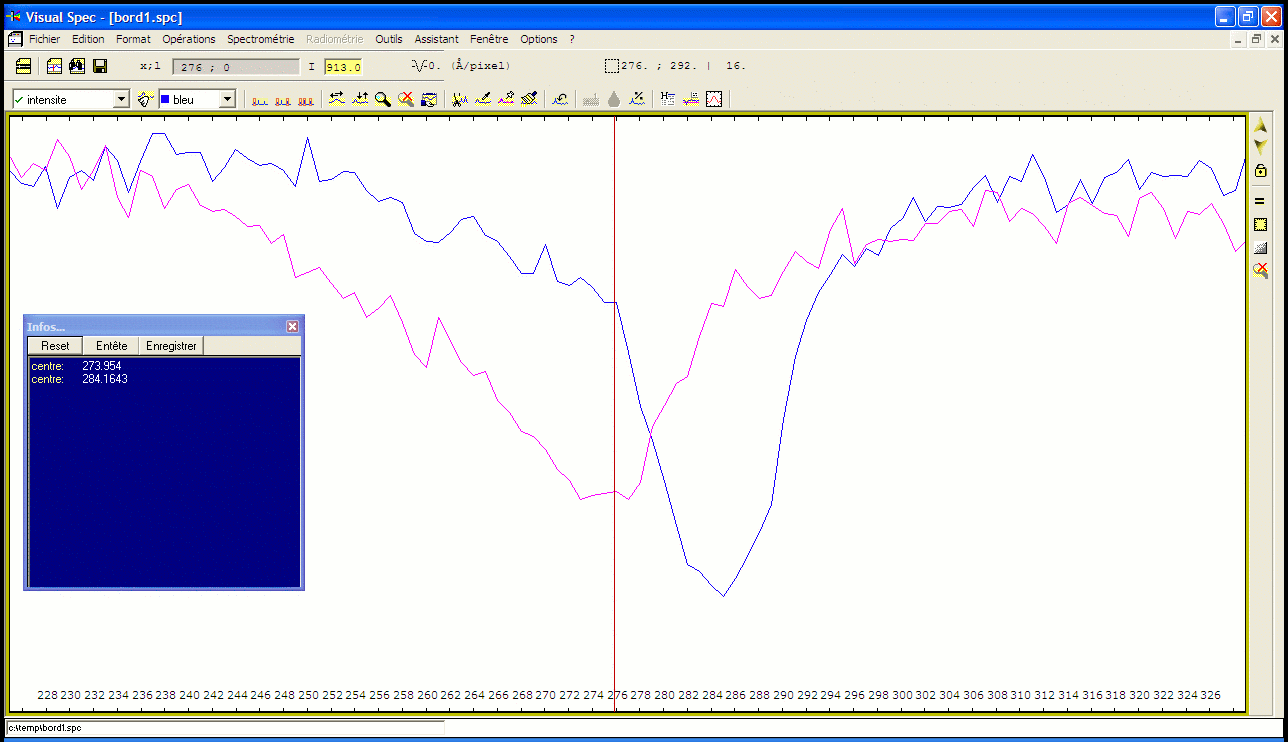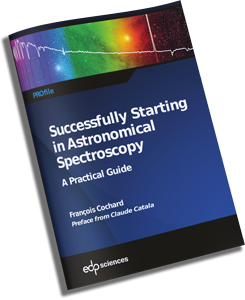Planet’s rotation
Recommended equipment : Lhires III, eShel
Time : one evening (acquisition), 4h (analysis in group)
Introduction
Doppler-Fizeau effect is particularly visible on Jupiter or Saturn spectra taken with Lhires III. One spectrum os Jupiter is enough to show the absorption line tilt compared to the line from our atmosphere (straight). The High Resolution of the Lhires III gives enough accuracy to measure the shift on each planet’s edges. eShel spectrograph can also be used by taking two spectra, one for each side of the planet.
This project is well adapted for 10th-12th grade with an easy practical workshop for acquisition and half a day for the analysis and well understand the phenomena. Student will be able to calculate the rotational speed of Jupier, its dimension…
This article was initially published in AstroSurf magazine in french.
Doppler-Fizeau effect
Starlight analysis tell us about star composition, physical conditions such as temperature, pressure, gravity… Spectra also contain speed information thanks to the Doppler-Fizeau effect.
For “low” speed (let say below 10 000 km/s), wavelength shift dl is tied to radial velocity Vr by Doppler-Fizeau formula :
where λ is the wavelength measured in laboratory and c the speed of light in empty space (constant: c=300 000 km/s). Around Halpha, a 50km/s speed will create a spectral shift of 0,1nm (or 1Å). This isn order of magnitude to keep in mind…
Doppler-Fizeau shift is toward greater wavelength when the source and observer move away from each other (redshift when seen in visible spectral domain) and toward smaller wavelength when the approach from each other (blue shift). Red shift is now famous since Hubble, in the 1930’s, showed that most galaxies are moving away from ours due to our space expansion.
Be careful as those measured speed are radial velocities; ie: projected speed toward the line of sight between observer and the source. Accuracy reached with this method is very high.
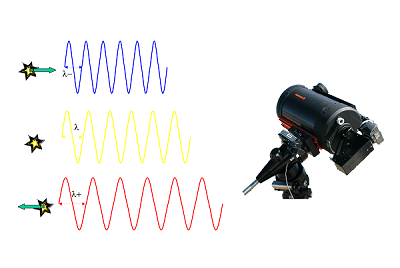
Doppler-Fizeau effect
Giant planets such as Jupiter and Saturn reflect light from the Sun. Their spectra are very closed to solar spectrum. Those planets, very large, are well resolved with amateur telescope, specially with long focal length (4 meters or more is recommended) where spectrum will be very large.
Jupiter
A high spectral resolution is required to detect the wavelength shift due to the planet’s rotation. Lhires III, with a resolution about 0.3Å, makes this exercise easy to do. eShel optical fibre echelle spectrogaph will work too by recording two spectra (one for each side); Lhires III slit makes this project simplier and more spectacular!
Jupiter spectrum which is used in this article has been done with a C11 F/10 and a Lhires III (2400 lines/mm grating module). A 30µm slit has been used : the planet is visible on the guiding imager while the spectrum taken is only of the line going through the slit. Aligning the slit with the planet’s equator allows to measure the spectrum on the equator where the rotational linear speed is the the greatest.

Jupiter spectrum (5min exposure)
Some absorption lines are tilted. This is due to the the planet’s rotation: the edge approaching toward us is shifted toward the blue while the other edge is moving away from us and redshifted spectrally. The Doppler-Fizeau shift is proportional to the speed itself giving the tilted line on the resolved spectrum. Some vertical lines are also visible: those are created by our Earth atmosphere – it’s normal they remain straight as our atmosphere is fixed compared to us.
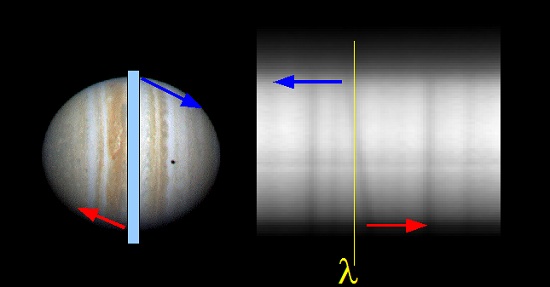
How does-it works ?
This project is very simple as the exposure time is short and all the information is included in a single image.
Measuring the wavelength shift Dl between each line will allow to calculate the linear speed at planet’s edge compared to planet’s center following the equation :
Vr=¼ .c.Δλ / λ
Why this ‘¼’ factor ? First because we measure two edges, so the speed is measured twice: one for each side. But also the Doppler-Fizeau effect is working twice: first when the light from our Sun is arriving on the planet… and second when it is reflected and leaves the planet. In total, the Doppler-Effect is operating four times.
On Jupiter’s spectrum, we first do a vertical cut to find the edge position: Y=92 and Y=224 in our exemple.
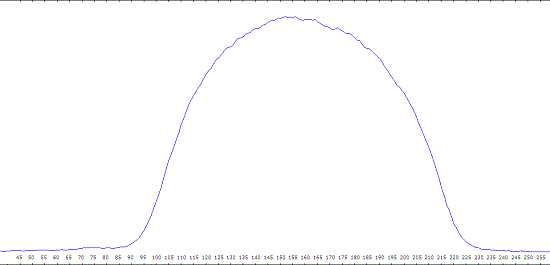
Vertical cut of Jupiter spectrum
Measure of the gap between each side of Jupiter (click to enlarge)
We extracted each edge spectrum and measured Halpha position with VisualSpec. Measured shift is 10.2 pixels with a spectrograph dispersion of 0.0115 nm/pixel. Radial velocity at Jupiter’s equator is then :
v = ¼ * 300 000 * 10.2 * 0.0115 / 656.3 = 13.4 km/s
Let’s go a little further. When observing Jupiter visually, one can notice its rotational period of P=9.84h (look at the red spot for exemple); we then deduct Jupiter’s diameter D :
D = v.P / π = 13.4*9.84*3600/3.1415 = 151 100 km
This is very close to encyclopedia values: D=140 000 km. Difference is the accuracy in aligning the slit to equator, planet’s inclination and of course our measurement accuracy.
The most curious of you would certainly want to go even further: satellite’s periods allow to measure jupiter’s mass, then deduct the density…
Saturne
From Saturn’s image to its spectrum
The exercise on Saturn is similar with, on top, ring’s rotation. This is illustrated with a spectrum taken by Christian Buil (Lhires III, digital SLR) around infra-red spectral domain. Thin solar spectral line are tilted and well visible. Large dark absorption bands are seen on the planet but not the rings: those are methan bands from Saturn gaz.

Near Infra-Rouge spectrum of Saturn (Christian Buil)
The spectrum which we will use for our calculation has been taken at CALA observatory with a Lhires III (2400 lines/mm, C14 F/10, Audine KAF400 CCD camera).

Saturn spectrum (Lhires III)
On planet only, measured Doppler-Fizeau shift is 8.33 pixels with a dispersion stiil of 0.0115 nm/pixel. We deduct linear speed at equator:
v = ¼*300 000 * 8.33 * 0.0115 / 656.3 = 10.9 km/s
rotational period is harder to measure but can be done when a cyclone appears on the planet; it isP=10.66h. Diameter of Saturen is calculated by :
D = v.P / π = 10.9 * 10.66 * 3600 / 3.1415 = 133 000 km
This is close to encyclopedia values of 120 000 km.
Ring’s spectrum is very different compared to planet’s one: the tilt is not visible. Speed is linear and actually proportional to planet’s distance. This indicates that while the planet rotate almost as a solid body, the ring have a constant speed (with our accuracy). Higher accuracy would show they rotate as a kelperian body because they are not a single body but a group of small bodies following Kelper’s law :
a3/T2=Cte
Conclusions
Observations we described here are interesting in pultiple way, specially if you are starting in spectroscopy:
- it takes little time as objects are very bright (and easy to center on the slit!)
- all information is contain in a single short exposure image
- result is impressive: tell your friend you have measured Saturn’s dimension from your backyard!!!
This is great educational project – do not hesitate to embark 10-12th grade students, club members or anyone else in your backyard to help them discovering astrophysics and its potential!
References :
- Acker, Agnès & Jaschek Carlos: “Astronomie, méthode et calculs”, édition Masson.
- See also the excellent document from university of Utrecht: http://www.staff.science.uu.nl/~rutte101/rrweb/rjr-edu/exercises/assignments-spectral-lines/line-usage.pdf
- Similar project by other Lhires III users
Torsten Hansen: Lhires III (2400 gr/mm) and DMK41. 4exposures of 20-30sec added, dark removed. H-Alpha Jupiter (click to enlarge) :

